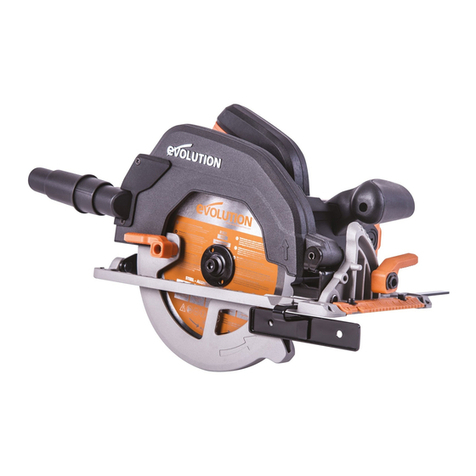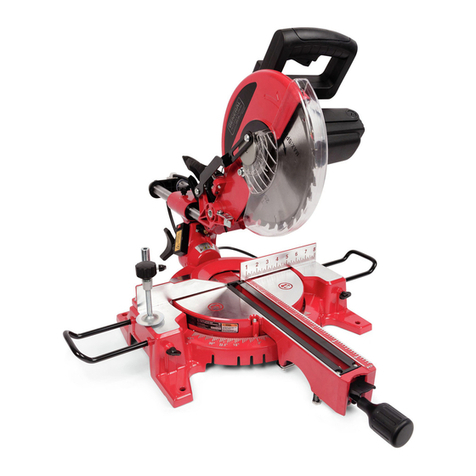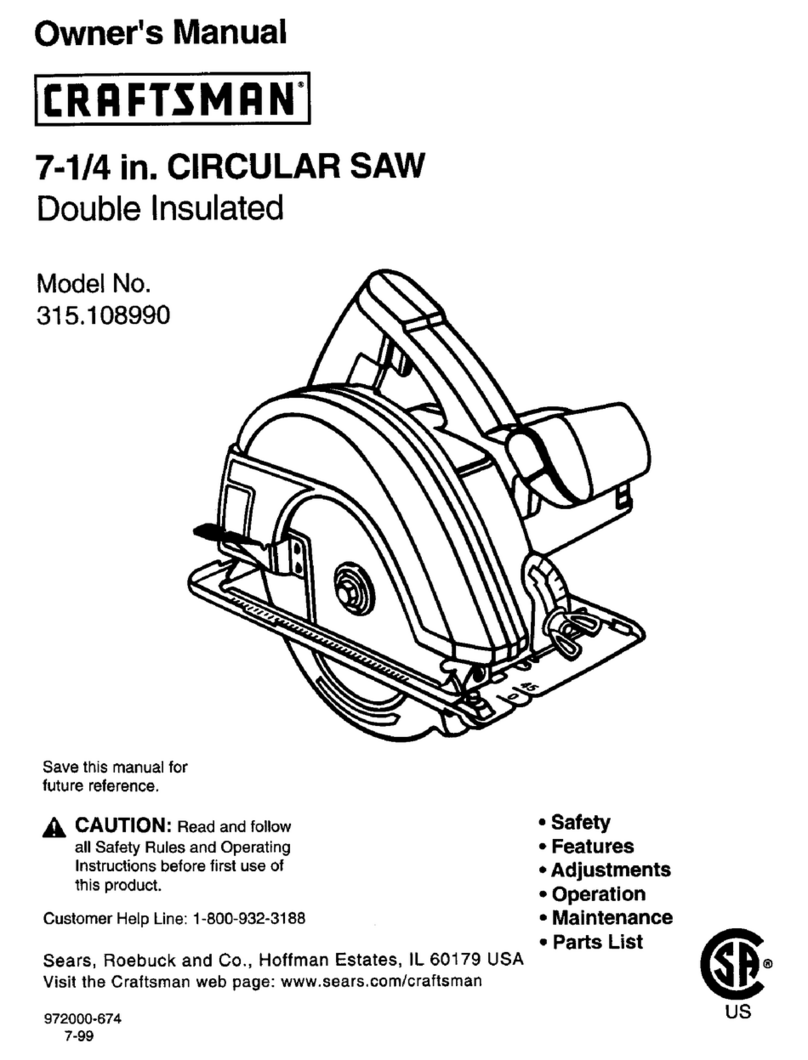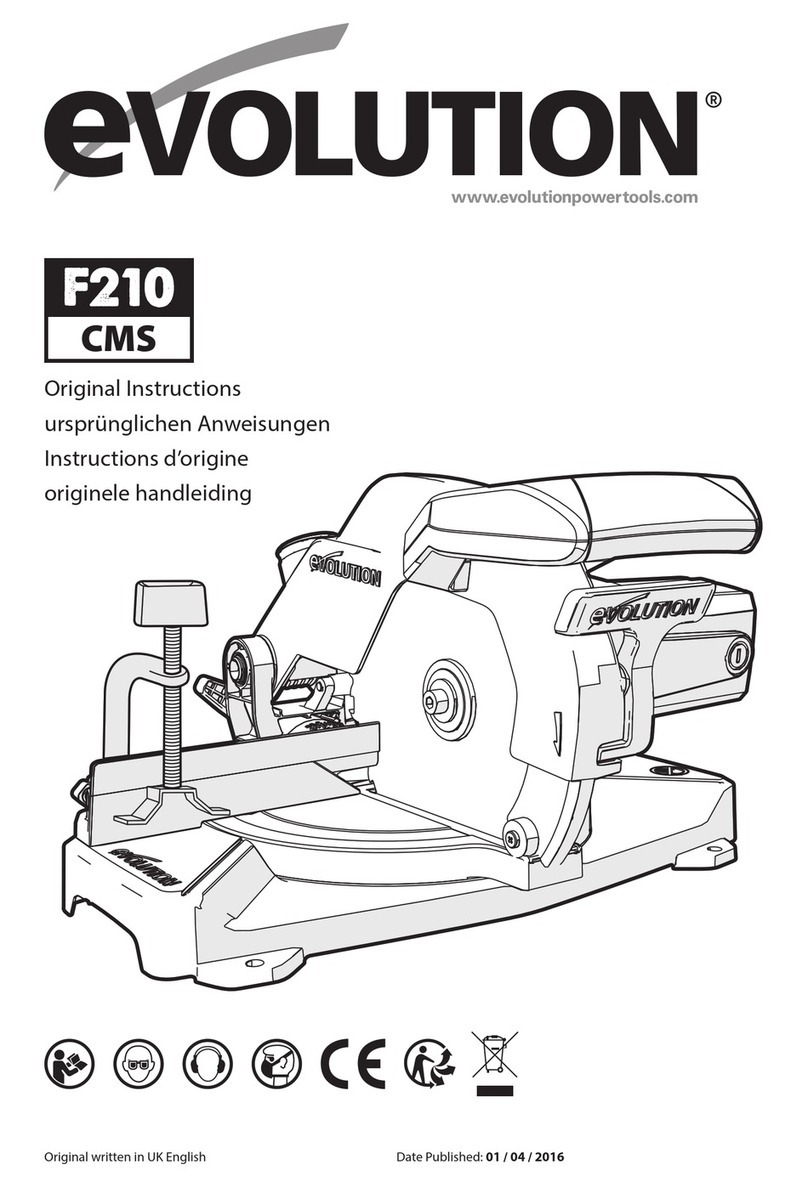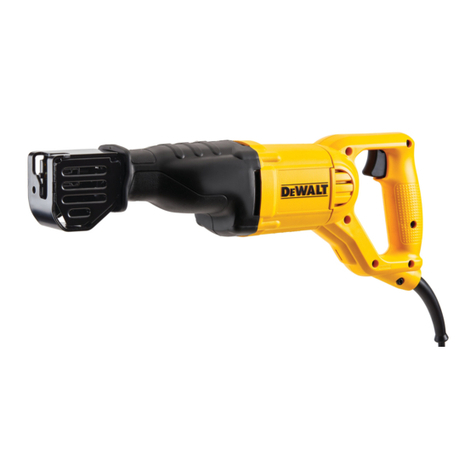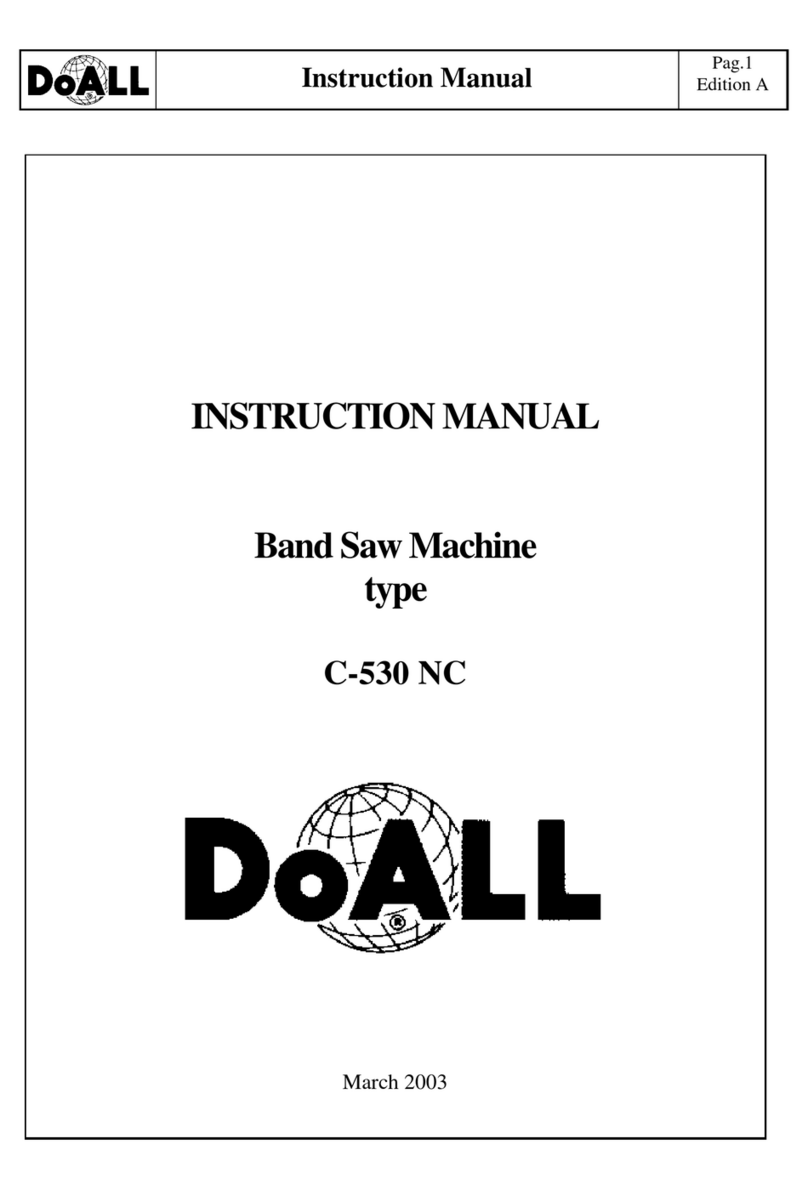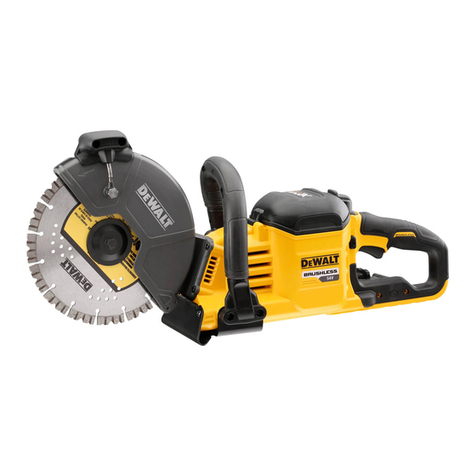Benchmark 1270-001 User manual

RECIPROCATING SAW
WEAR CSA APPROVED
EYE PROTECTION
WEAR EAR
PROTECTION
WEAR A
FACE MASK
3042597
JD3506U
READ ALL INSTRUCTIONS BEFORE FIRST USE.
KEEP THIS MANUAL FOR FUTURE REFERENCE.
KEEP AWAY FROM CHILDREN.
5 Year Limited Warranty on tool

1
PRODUCT SPECIFICATIONS
12A VARIABLE SPEED RECIPROCATING SAW
Rating 120v, 60hz, AC
Amperes 12 Amp
Speed 0 - 2,800 Spm (No Load)
Stroke Length 1 1/4" (32mm)
Maximum Cutting Depth In Wood 4 1/2" (115mm)
Maximum Cutting Depth In Steel 5/8" (15mm)
Blade Change System Tool-Less
Weight 9.9 Lb (4.5kg)
NEED ASSISTANCE?
Call us on our toll-free customer support line:
1-866-349-8665 (Monday through Friday 9am – 5pm Eastern Standard Time)
• Technical questions
• Replacement parts
• Parts missing from package

2
VARIABLE SPEED RECIPROCATING SAW 1270-001
TABLE OF CONTENTS
Product Specifications................................................................................... 1
Table of Contents........................................................................................... 2
General Safety Instructions ............................................................................ 3
Eye, Ear & Lung Protection............................................................................. 3
Electrical Safety............................................................................................. 4
Power Tool Safety........................................................................................... 4
Work Area Safety ........................................................................................... 4
Electrical Safety............................................................................................. 4
Personal Safety.............................................................................................. 5
Power Tool Use and Care................................................................................ 5
Service .......................................................................................................... 6
Specific Safety Rules for Reciprocating Saw ................................................... 6
Extension Cord Safety .................................................................................... 7
Symbols......................................................................................................... 9
Know Your Benchmark Reciprocating Saw ................................................... 10
Assembly and Operating .............................................................................. 10
Installing a Blade ......................................................................................... 10
Removing a Blade........................................................................................ 11
Adjusting the Pivoting Shoe.......................................................................... 11
Orbital Control Knob .................................................................................... 11
Variable Speed Trigger Switch ...................................................................... 12
Materials You Can Cut.................................................................................. 12
Cutting Wood ............................................................................................... 13
Plunge Cutting ............................................................................................. 14
Metal Cutting............................................................................................... 15
Exploded View ............................................................................................. 16
Parts List ..................................................................................................... 17
Maintenance ............................................................................................... 18
General........................................................................................................ 18
Lubrication .................................................................................................. 19
Replacing Carbon Motor Brushes ................................................................. 19
Warranty...................................................................................................... 20

3
GENERAL SAFETY INSTRUCTIONS
WARNING: Before using this tool or any of its accessories, read this manual
and follow all Safety Rules and Operating Instructions. The important precautions,
safeguards and instructions appearing in this manual are not meant to cover all
possible situations. It must be understood that common sense and caution are
factors which cannot be built into the product.
EYE, EAR & LUNG PROTECTION
SYMBOL MEANING
ALWAYS WEAR EYE PROTECTION THAT CONFORMS
WITH CSA Z94.3 or ANSI SAFETY STANDARD Z87.1
FLYING DEBRIS can cause permanent eye damage.
Prescription eyeglasses ARE NOT a replacement for proper
eye protection. The usage of a safety standard compliant
face shield placed over proper safety glasses or goggles
can reduce the risk of facial injury.
Non-compliant eyewear can cause serious injury if broken
during the operation of a power tool.
Use hearing protection, particularly during extended periods
of operation of the tool, or if the operation is noisy.
WEAR A DUST MASK THAT IS DESIGNED TO BE
USED WHEN OPERATING A POWER TOOL IN A
DUSTY ENVIRONMENT.
Dust that is created by power sanding, sawing, grinding,
drilling, and other construction activities may contain
chemicals that are known to cause cancer, birth defects,
or other genetic abnormalities. These chemicals include:
• Lead from lead-based paints
• Crystalline silica from bricks, cement, and other
masonry products
• Arsenic and chromium from chemically treated lumber
The level of risk from exposure to these chemicals varies,
according to how often this type of work is performed. In
order to reduce exposure to these chemicals, work in a
well-ventilated area, and use approved safety equipment,
such as a dust mask that is specifically designed to filter
out microscopic particles.

4
VARIABLE SPEED RECIPROCATING SAW 1270-001
ELECTRICAL SAFETY
WARNING: To avoid electrical hazards, fire hazards or damage to the tool,
use proper circuit protection.
This tool is wired at the factory for 120V AC operation. It must be connected to a
120V AC, 15 A circuit that is protected by a time-delayed fuse or circuit breaker.
To avoid shock or fire, replace power cord immediately if it is worn, cut or damaged
in any way.
POWER TOOL SAFETY
WARNING: Read all safety warnings and instructions. Failure to follow the
warnings and instructions may result in electric shock, fire and/or serious injury.
Save all warnings and instructions for future reference.
WORK AREA SAFETY
Keep work area clean and well lit. Cluttered or dark areas invite accidents.
Do not operate power tools in explosive atmospheres, such as in the presence
of flammable liquids, gases or dust. Power tools create sparks which may ignite
the dust or fumes.
Keep children and bystanders away while operating a power tool. Distractions
can cause you to lose control.
ELECTRICAL SAFETY
Power tool plugs must match the outlet. Never modify the plug in any way.
Do not use any adapter plugs with earthed (grounded) power tools. Unmodified
plugs and matching outlets will reduce risk of electric shock.
Avoid body contact with earthed or grounded surfaces such as pipes, radiators,
ranges and refrigerators. There is an increased risk of electric shock if your body is
earthed or grounded.
Do not expose power tools to rain or wet conditions. Water entering a power tool
will increase the risk of electric shock.
Do not abuse the cord. Never use the cord for carrying, pulling or unplugging
the power tool. Keep cord away from heat, oil, sharp edges or moving parts.
Damaged or entangled cords increase the risk of electric shock.
When operating a power tool outdoors, use an extension cord suitable for
outdoor use. Use of a cord suitable for outdoor use reduces the risk of electric
shock.
If operating a power tool in a damp location is unavoidable, use a residual
current device (RCD) protected supply. Use of a ground fault circuit interrupter
(GFCI) reduces the risk of electric shock.

5
PERSONAL SAFETY
Stay alert, watch what you are doing and use common sense when operating a
power tool. Do not use a power tool while you are tired or under the influence
of drugs, alcohol or medication. A moment of inattention while operating power
tools may result in serious personal injury.
Use personal protective equipment. Always wear eye protection. Protective
equipment such as dust mask, non-skid safety shoes, hard hat, or hearing
protection used for appropriate conditions will reduce personal injuries.
connecting to power source and/or battery pack, picking up or carrying the
tool. Carrying power tools with your finger on the switch or energizing power tools
that have the switch on invites accidents.
Remove any adjusting key or wrench before turning the power tool on. A wrench
or a key left attached to a rotating part of the power tool may result in personal
injury.
Do not overreach. Keep proper footing and balance at all times. This enables
better control of the power tool in unexpected situations.
Dress properly. Do not wear loose clothing or jewellery. Keep your hair, clothing
and gloves away from moving parts. Loose clothes, jewellery or long hair can be
caught in moving parts.
If devices are provided for the connection of dust extraction and collection
facilities, ensure these are connected and properly used. Use of dust collection
can reduce dust-related hazards.
POWER TOOL USE AND CARE
Do not force the power tool. Use the correct power tool for your application.
The correct power tool will do the job better and safer at the rate for which it was
designed.
Any power
tool that cannot be controlled with the switch is dangerous and must be repaired.
Disconnect the plug from the power source and/or the battery pack from the
power tool before making any adjustments, changing accessories, or storing
power tools. Such preventive safety measures reduce the risk of starting the power
tool accidentally.
Store idle power tools out of the reach of children and do not allow persons
unfamiliar with the power tool or these instructions to operate the power tool.
Power tools are dangerous in the hands of untrained users.
Maintain power tools. Check for misalignment or binding of moving parts,
operation. If damaged, have the power tool repaired before use. Many accidents
are caused by poorly maintained power tools.
Keep cutting tools sharp and clean. Properly maintained cutting tools with sharp
cutting edges are less likely to bind and are easier to control.

6
Use the power tool, accessories and tool bits etc. in accordance with these
instructions, taking into account the working conditions and the work to be
performed.
result in a hazardous situation.
Hold power tool by insulated gripping surfaces when performing an operation
where the cutting tool may contact hidden wiring or its own cord. Contact with a
“live” wire will make exposed metal parts of the tool “live” and shock the operator.
Use clamps or another practical way to secure and support the workpiece to a
stable platform. Holding the work by hand or against your body leaves it unstable
and may lead to loss of control.
SERVICE
Have your power tool serviced by a qualified repair person using only identical
replacement parts. This will ensure that the safety of the power tool is maintained.
SPECIFIC SAFETY RULES FOR RECIPROCATING SAW
WARNING: Know your reciprocating saw. Do not plug in the tool until you
have read and understand this Instruction Manual. Learn the tool’s applications
and limitations, as well as the specific potential hazards related to this tool.
Following this rule will reduce the risk of electric shock, fire, or serious injury.
Always wear eye protection. Any power tool can throw foreign objects into
your eyes and cause permanent eye damage. ALWAYS wear safety goggles
(not glasses) that comply with ANSI safety standard Z87.1. Everyday glasses
have only impact resistant lenses. They ARE NOT safety glasses.
WARNING: Glasses or goggles not in compliance with ANSI Z87.1 could
cause serious injury when they break.
WARNING: Always use hearing protection when sawing, particularly during
extended periods of operation.
WARNING: Always unplug the tool from the power source before changing
the blade and when making any adjustments.
Do not wear gloves, neckties or loose clothing.
Hold the tool by its insulated gripping surfaces when performing an operation where
the saw blade may contact hidden wiring or its own cord. Contact with a “live” wire
will make exposed metal parts of the tool “live” and shock the operator.
Always hold the tool with two hands. Attempting to control the tool with only one
hand is dangerous. It could result in loss of control and serious injury.
Never hold the workpiece in one hand and the tool in the other hand when sawing.
Never place the hands near or below the cutting surface. Clamp the workpiece and
guide the tool with both hands.
Always make sure the work surface is free from nails and other foreign objects.
Cutting into a nail can cause the blade and the tool to jump and damage the blade.
VARIABLE SPEED RECIPROCATING SAW 1270-001

7
Never lay the workpiece on hard surfaces like concrete, stone, etc. The protruding
blade may cause tool to jump.
After changing a blade or making adjustments, make sure the blade clamp is
holding the blade securely. Loose blades could be violently thrown from the tool.
Never use dull or damaged blades. Sharp blades must be handled with care.
Damaged blades can snap during use. Dull blades require more force to cut the
workpiece, possibly causing the blade to break.
Never touch the blade during or immediately after use. After use the blade is too hot
to be touched.
EXTENSION CORD SAFETY
WARNING: Keep the extension cord clear of the working area. Position the
cord so it will not get caught on the workpiece, tools or any other obstructions while
you are working with the power tool.
Make sure any extension cord used with this tool is in good condition. When using
an extension cord, be sure to use one of heavy enough gauge to carry the current
the tool will draw. An undersized cord will cause a drop in line voltage resulting in
loss of power and overheating.
The table at right shows the correct size to use according to cord length and
nameplate ampere rating. If in doubt, use the next heavier gauge. The smaller the
gauge number the heavier the cord.
Be sure your extension cord is properly wired and in good condition. Always replace
a damaged extension cord or have it repaired by a qualified electrician before using
it. Protect your extension cord from sharp objects, excessive heat and damp or wet
areas.
Use a separate electrical circuit for your power tools. This circuit must not be less
than 14 gauge wire and should be protected with either a 15 AMP time delayed fuse
or circuit breaker. Before connecting the power tool to the power source, make sure
the switch is in the OFF position and the power source is the same as indicated on
the nameplate. Running at lower voltage will damage the motor.
WARNING: Repair or replace damaged or worn extension cords
immediately.
Select the appropriate extension cord gauge and length using the chart below.
WHEN OPERATING A POWER TOOL OUTDOORS, USE AN OUTDOOR
EXTENSION CORD MARKED “W-A” OR “W”. These cords are rated for outdoor
use and reduce the risk of electric shock.
WARNING: Keep the extension cord clear of the working area. Position the
cord so it will not get caught on the workpiece, tools or any other obstructions
while you are working with the power tool.

8
VARIABLE SPEED RECIPROCATING SAW 1270-001
MINIMUM GAUGE (AWG) EXTENSION CORDS (120V USE ONLY)
Amperage Rating Total Length
More than Not more
than 25'
(7.5 m) 50'
(15 m) 100'
(30 m) 150'
(45 m)
0 6 18 16 16 14
6 10 18 16 14 12
10 12 16 16 14 12
12 16 14 12 Not Applicable

9
SYMBOLS
WARNING: Some of the following symbols may appear on the reciprocating
saw. Study these symbols and learn their meaning. Proper interpretation of these
VVOLTS Three-phase alternating current
with neutral
AAmperes Direct current
Hz Hertz noNo load speed
WWatts Alternating or direct current
kW Kilowatts Class II construction
ųF Microfarads Splash-proof construction
LLitres Watertight construction
kg Kilograms Protective grounding at grounding
terminal, Class I tools
HHours .../min Revolutions or reciprocations per
minute
N/cm2Newtons per
square centimeter ØDiameter
Pa Pascals 0
OPM Oscillations per minute Arrow
MIN Minutes Warning symbol
SSeconds Wear your safety glasses
Alternating current Wear a dust mask
Three-phase alternating
current Wear hearing protection
3042597
JD3506U
This symbol designates that this tool is listed with U.S. requirements by
ETL Testing Laboratories, Inc.
UL62841-1,UL62841-2-11;
CSA C22.2#62841-1,CSA C22.2#62841-2-11.

10
VARIABLE SPEED RECIPROCATING SAW 1270-001
KNOW YOUR BENCHMARK RECIPROCATING SAW
Tool Free
Blade Holder
Orbital
Control Knob
Motor
Vents
Variable Speed
Trigger Switch
Pivoting
Shoe
Pivoting Shoe
Adjusting Lever
Rafter
Hook
Wood and Metal Cutting Blades NOTE: The rafter hook
can be rotated left or right
to rest against the handle.
NOTE:
This reciprocating saw has a built- in anti-vibration system that is automatically
functioning when the tool is turned ON. This anti-vibration system reduces fatigue
during extended periods of use and enhances your ability to control the tool.
WARNING: Use only universal fitting reciprocating saw blades that are designed
for the material being cut. Inappropriate blades may bend or shatter causing serious
personal injury.
ASSEMBLY AND OPERATING
INSTALLING A BLADE
WARNING: Always remove the plug from the power source before installing
or removing a blade or adjusting the saw in any way.
1. To install a blade in the saw, rotate the blade locking sleeve (1) counter clockwise
(Fig. 1).
2. Insert the appropriate blade (2) into the blade slot (3) as far as it will go.
3. Release the blade locking sleeve.

11
NOTE: The blade will automatically be locked into the blade holder. Pull outward
on the blade to ensure it is properly locked into the blade holder.
REMOVING A BLADE
To remove a blade, simply rotate the blade locking sleeve counter clockwise and
remove the blade from the blade holder.
ADJUSTING THE PIVOTING SHOE
The pivoting shoe will pivot to follow the angle of the blade to the workpiece.
This action ensures the flat surface of the shoe is against the workpiece for better
cutting action and easier control of the saw.
points on the blade. This will provide longer blade life as one section of the blade
becomes dull.
1. To adjust the pivoting shoe (1), rotate the pivoting shoe adjusting lever (2)
to its downward position (3) (Fig. 2).
2. Slide the pivoting shoe in or out until it is in the appropriate position.
3. Lock the pivoting shoe in place by rotating the pivoting shoe adjusting lever
upward to its original horizontal position.
4. Pull outward on the pivoting shoe to ensure it is firmly locked in place.
1 2 3 1
3 2
ORBITAL CONTROL KNOB
This reciprocating saw has two cutting actions. The conventional reciprocating
action produces a smoother cut with less splintering. The orbital reciprocating
action is more aggressive and produces rougher cuts.
To operate the saw in conventional cutting mode, rotate the orbital control knob
(1) counter clockwise (Fig. 3). To operate the saw in orbital cutting mode, rotate the
orbital control knob clockwise (2).
WARNING: Always remove the plug from the power source when changing
the orbital control knob. Changing the orbital control knob with the saw
operating may cause serious personal injury and damage the saw.

12
VARIABLE SPEED RECIPROCATING SAW 1270-001
1 1
VARIABLE SPEED TRIGGER SWITCH
The variable speed trigger switch controls both the ON/OFF function and the speed
of the tool.
1. To turn the saw ON, squeeze the switch trigger (1) slightly (Fig. 4).
NOTE: The saw will start at its slowest speed.
2. To increase the speed of the saw, squeeze the switch trigger harder.
NOTE: When the switch trigger is squeezed fully, the saw will run at its
maximum speed.
3. To turn the saw OFF, release the switch trigger.
1
MATERIALS YOU CAN CUT
of materials. Some of these materials include:
• Wood products such as lumber, hardwood, plywood, composite board,
and paneling
• Drywall
• Fiber board and plastic
• Metals, such as pipe, steel rods, sheet steel, aluminum, brass, and copper

13
NOTE:
cutting blades (fine teeth) and wood cutting blades (coarse teeth). Use the correct
blade for your application. The packaging on the blade will indicate the type of
materials each blade is designed to cut.
WARNING: For safety reasons, the operator must read the sections of this
Owner’s Manual entitled “GENERAL SAFETY WARNINGS”, “POWER TOOL
SAFETY”, “SPECIFIC SAFETY RULES”, “EXTENSION CORD SAFETY” and
“SYMBOLS” before using this reciprocating saw.
Verify the following every time the reciprocating saw is used:
1. The correct blade for the material being cut is installed in the saw.
2. The blade is firmly clamped in the blade holder.
3. The blade is sharp and in good condition.
4. The workpiece is properly secured.
5. Safety glasses and hearing protection are being worn.
Failure to observe these safety rules will significantly increase the risk of injury.
CUTTING WOOD
1. Clearly mark the workpiece to locate the position of the cut.
2. Hold smaller workpieces with a vice. Clamp larger workpieces to a workbench
or table.
DANGER: Any workpiece that is not adequately clamped in place may come
loose and cause serious injury. Never hold the workpiece with your hand.
3. Make sure there are no nails, screws, clamps or foreign materials in the path of
the saw blade.
4. Set the orbital control knob to either conventional or orbital cutting to produce
5. Hold the saw away from your body and infront of you (Fig. 5).
6. With both hands firmly gripping the saw, and with the blade NOT in contact with
the surface to be cut, start the saw by squeezing the switch trigger.
7. Once the saw has reached the desired speed, place the adjustable pivoting shoe
against the workpiece and gradually bring the moving blade into contact with the
workpiece at the appropriate location.
CAUTION: Do not force the saw. Use only enough force to keep the blade
cutting. Excessive pressure on the blade will cause it to bend and twist, which
may result in breaking the blade.

14
VARIABLE SPEED RECIPROCATING SAW 1270-001
PLUNGE CUTTING
1. Clearly mark the workpiece to locate the position of the cut.
2. Clamp the workpiece to a workbench or table (Fig. 6).
NOTE: Make sure the area to be cut is clear under the workpiece so that the blade
will not come into contact with anything other than the workpiece.
3. Set the orbital control knob to conventional cutting (Fig. 3).
WARNING: Never set the orbital control knob to orbital setting when plunge
cutting. If you do, blades may bend or break and serious injury may result.
4. Select a convenient starting point in the area to be cut out. Place the tip of the
blade over that point.
5. Rest the lower edge of the adjustable pivoting shoe on the workpiece and hold
it firmly in that position, maintaining a shallow cutting angle.
6. Squeeze the switch trigger to start the saw.
WARNING: Make sure the blade does not touch the workpiece until the saw
reaches full speed. Loss of control and possible injury could result.
7. With the saw running at full speed, slowly tilt the saw until the tip of the blade
contacts the workpiece and begins to cut. After the blade cuts through the
workpiece, tilt the saw upward until the blade is perpendicular to the workpiece.

15
METAL CUTTING
Metals such as pipe, steel rods, sheet steel, aluminum, brass and copper can be
cut with your reciprocating saw (Fig. 7).
Set the orbital control knob to conventional cutting (Fig. 3).
WARNING: Never set the orbital control knob to orbital setting when plunge
cutting. If you do, blades may bend or break and serious injury may result.
To cut thin sheet material, "sandwich" the material between hardboard or plywood
and clamp the layers to limit vibration and material tearing.
Always use a fine toothed metal cutting blade and run the saw at medium speeds
when cutting metal.
Use cutting oil to keep the blade cool, increase cutting action, and prolong the life
of the blade.
Do not twist or bend the saw blade.
Do not force the saw blade. Let it cut at its own speed.
DANGER: a) Always clamp the workpiece in a vice, or to a workbench or table.
Do not hold the workpiece in your hand. b) Never use gasoline as a lubricant or as
a cleaning agent. A spark from the motor may cause an explosion. Gasoline will
also damage the plastic components of the saw.

16
VARIABLE SPEED RECIPROCATING SAW 1270-001
EXPLODED VIEW
1
2
3
4
5
6
8
9
11
15
14
13
16
17
18
19
20
53
52
51
50
49
48
70
73
75
77
78
31
32
61
62
63
64
69
67
66
65
54
55
56
58
23
22 21
26
25
24
33
34
35
36
28
29
30
60
59
7
10
37
38
39
40
41
42
43
44
45
46
47
12
27
57
90
76
80
81
82
83
84
86
87
68
71
72
74
85
88
79
89

17
PARTS LIST
Always order by key number.
KEY # PART # PART NAME / QUANTITY KEY # PART # PART NAME / QUANTITY
16060030005 Saw Blade /1 33 4020010161 Screw M5*12 /4
22030110013 Circlip Ø12 /1 34 2040160188 Pin /1
33120060060 Tool Less Blade Release /1 35 4010010094 Bearing 697-2rs /2
42050050045 Ring Spring /1 36 2030020326 Flat Washer Ø7.5*Ø12*0.5 /1
52040310033 Blade Holder /1 37 2010150052 Supporting Clamp /1
62040310034 Sleeve /1 38 1230030028
Brush Cap
/2
72040160171 Locking Pin /1 39 1230010145 The Carbon Brush /2
83140020124 Sealing Ring /1 40 1230030027 Brush Holder /2
92040310043 Locating Ring /1 41 3120070127 Handle /1
10 3150130132 Support Plate /1 42 1062020063 Speed Control Switch /1
11 3140020125 O Sealing Ring /1 43 2030050002 Strain Relief Holding Plate /1
12 2050060204
Spring
/1 44 4030010099 Screws St3.9*14 /4
13 4100050002 Circlip 6mm /2 45 3140010080 Strain Relief /1
14 2010080122 Bearing /2 46 1130030047 The Heat Sink /1
15 2020140013 Blade Holder /1 47 1190290014 Power Cord /1
16 2040160185 Pin /1 48 4030010106 Screws /6
17 3140020121 Gasket /1 49 4030010125
Screws
/2
18 4100020006 Shaft Retainer Ring Ø8 /1 50 3011110015
Motor Housing
/1
19 2020020047 Upper Cover /1 51 3150050089
Air Flow Guide
/1
20 4020010162 Screws /1 52 1020110011
Stator
/1
21 2040160190 Gear Shaft /2 53 4030010120
Screws St3.9*60
/2
22 2050060230 Spring /2 54 4010010036
Bearing 608-2z
/1
23 1160030077 Knob /1 55 3150240009
Washer
/1
24 3140020123 O Ring /2 56 1010110013
Rotor
/1
25 2050060229 Springs /2 57 3190010045
Oil Retaining Felt
/1
26 2040290082 Spindle /1 58 4020010147
Screw M4*12
/2
27 2040160170 Pin /1 59 2030160137
Plate
/1
28 1150010041 Reciprocating Rod /1 60 4010010081
Bearing 6201-2rs
/1
29 2010150054 Support /1 61 2030020325 Flat Washer Ø12.1*Ø25*1 /1
30 3140020124 Sealing Ring /1 62 2040310041
Set Ø11.8*Ø16.5*7
/1
31 2010150053 Support Bushing /1 63 4110130001
Locating Pin
/19
32 2030160140 Clamping Plate /1 64 2030270009
Nut
/1

18
KEY # PART # PART NAME / QUANTITY KEY # PART # PART NAME / QUANTITY
65 2040040104 Eccentric Drive /1 78 4030010114
Screws St 3.9*25
/4
66 2040160186 Locating Pins Ø5*15 /4 79 2030160148
Plate
/1
67 2010130046
Vibration Dampening Block /1
80 2030020327 Reed /1
68 2040160187 Locating Pin Ø4*15 /1 81 4020010143 Combination Screw /1
69 4020020010 Screws M4*10 /8 82 2040100003 Large Gear /1
70 2040310042 Support Plate /1 83 2030160138 Flexible Plate /1
71 2030010061 Foot Plate /1 84 4060010028 Hexagon Nut /1
72 3160040089 Dressing Sleeve /1 85 4010010014 Bearing 629-Rs /1
73 2010220004 Drive Wheel /1 86 3140020126 Sealing Ring /1
74 2030160139 Retaining Plate /1 87 2020020048 Bearing Cover /1
75 4010010084 Bearing 6002-Rs /1 88 1160040016
Adjustable Foot Locking Lever /1
76 2010080121 O Ring Ø22*Ø15.2*4 /1 89 2020020046 Gear Box /1
77 3140020122 O Ring /1 90 4020010163
Combination Screws M5*20 /1
MAINTENANCE
GENERAL
WARNING: When servicing, use only identical replacement parts.
The use of any other part may create a hazard or cause product damage.
DO NOT use solvents when cleaning plastic parts. Plastics are susceptible to
damage from various types of commercial solvents and may be damaged by their
use. Use a clean cloth to remove dirt, dust, oil, grease etc.
WARNING: DO NOT allow brake fluids, gasoline, petroleum-based
products, penetrating oils, etc. to come into contact with plastic parts.
They contain chemicals that can damage, weaken or destroy plastic.
DO NOT abuse power tools. Abusive practices can damage the tool and the
workpiece.
WARNING: DO NOT attempt to modify tools or create accessories.
Any such alteration or modification is misuse and could result in a hazardous
condition leading to possible serious injury. It will also void the warranty.
It has been found that electric tools are subjected to accelerated wear and
possible premature failure when they are used on fiberglass boats and sports
cars, wallboard, spackling compounds or plaster. The chips and grindings from
these materials are highly abrasive to electric tool parts such as bearings, brushes,
commutators, etc. Consequently, it is not recommended that this tool be used
for extended work on any fiberglass material, wallboard, spackling compounds or
plaster. During any use on these materials it is extremely important that the tool is
cleaned frequently by blowing it out with an air jet.
VARIABLE SPEED RECIPROCATING SAW 1270-001

19
WARNING: Always wear safety goggles or safety glasses with side shields
during all cutting operations. It is critical that you also wear safety goggles or
safety glasses with side shields and a dust mask while blowing dust out of the
reciprocating saw with an air jet. Failure to take these safety precautions could
result in permanent eye or lung damage.
LUBRICATION
lubricant for the life of the unit under normal conditions. Therefore, no further
lubrication is required.
REPLACING CARBON MOTOR BRUSHES
The carbon motor brushes will wear down and require replacing. The time intervals
between replacements will vary depending upon the working environment and the
hours of use. It is recommended that the brushes be checked after each 10 hours
of use. When the length of the carbon brush reaches 1/4" (6.35 mm), the brushes
should be replaced.
WARNING: Unplug the tool from the power source.
1. Use a 3/16" (5 mm) slot screwdriver and remove one brush cap (1) (Fig. 8).
Turn the brush cap counter-clockwise to remove it from the motor housing.
2. Pull the spring & brush assembly (2) from the brush holder (3) in the motor
housing (4).
3. Insert the new spring & brush assembly into the motor housing.
4. Compress the spring into the brush holder and thread the brush cap back into the
motor housing. NOTE: Make sure the brush cap threads are not cross-threaded.
Do NOT over tighten.
5. Repeat steps 1 to 4 to replace the second carbon brush located on the opposite
side of the motor housing.
1
2
3
4
FIG. 8
Table of contents
Other Benchmark Saw manuals
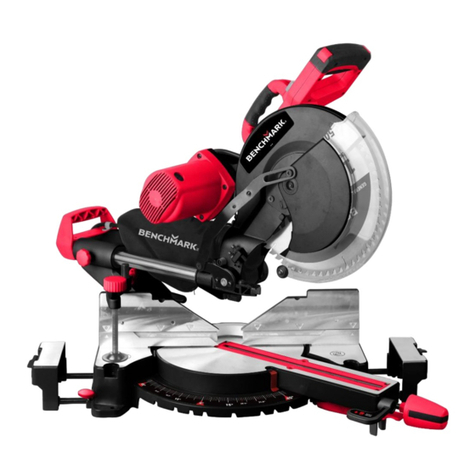
Benchmark
Benchmark 1347-006 User manual
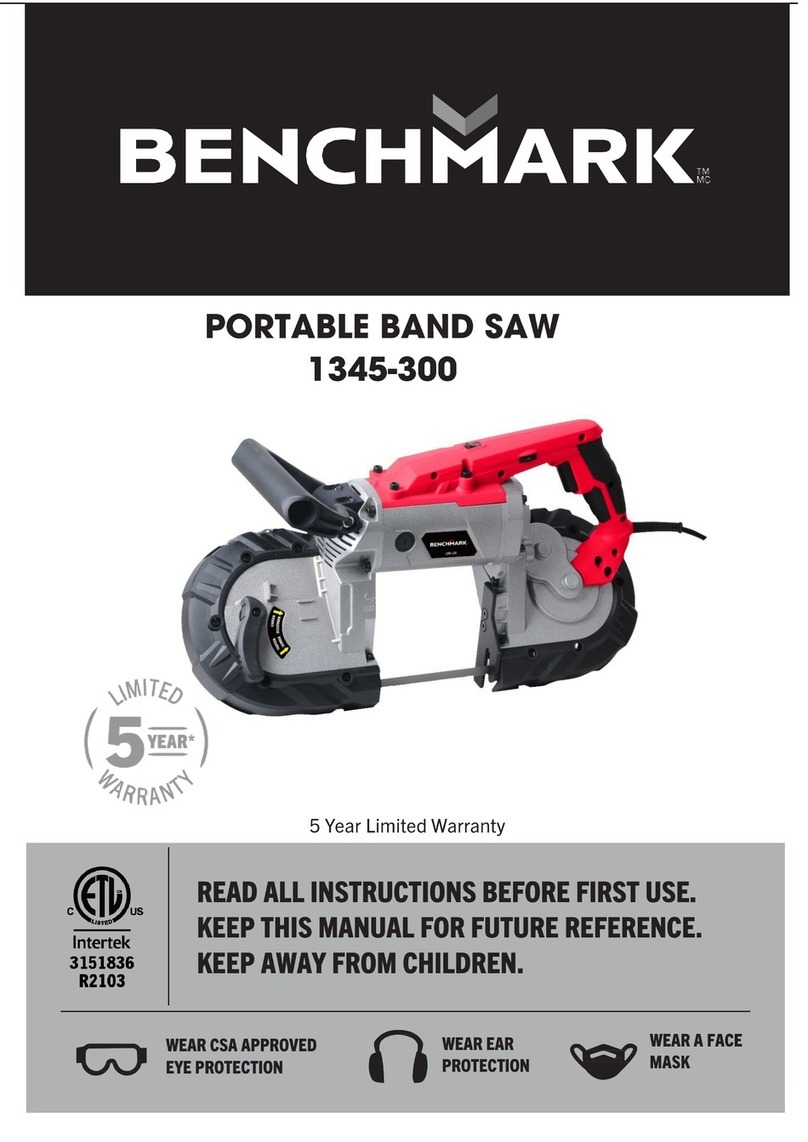
Benchmark
Benchmark 1345-300 User manual
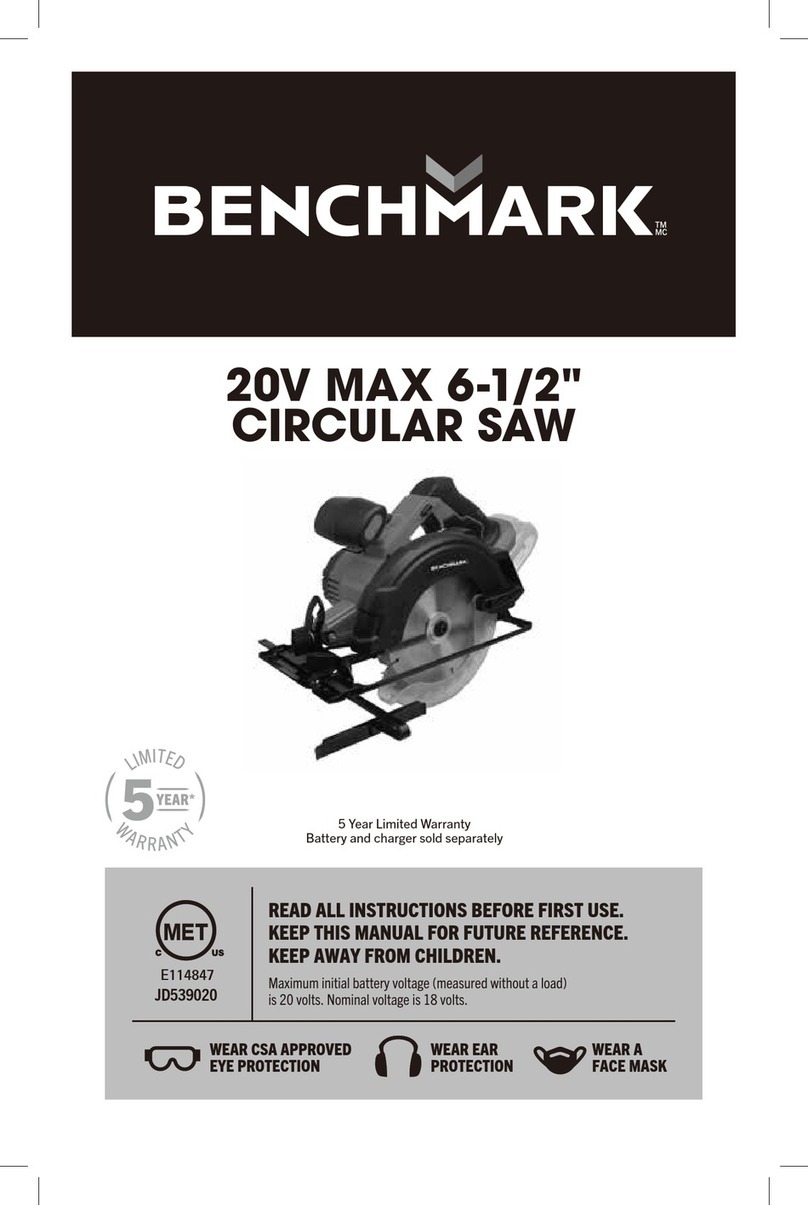
Benchmark
Benchmark 1265-001 User manual
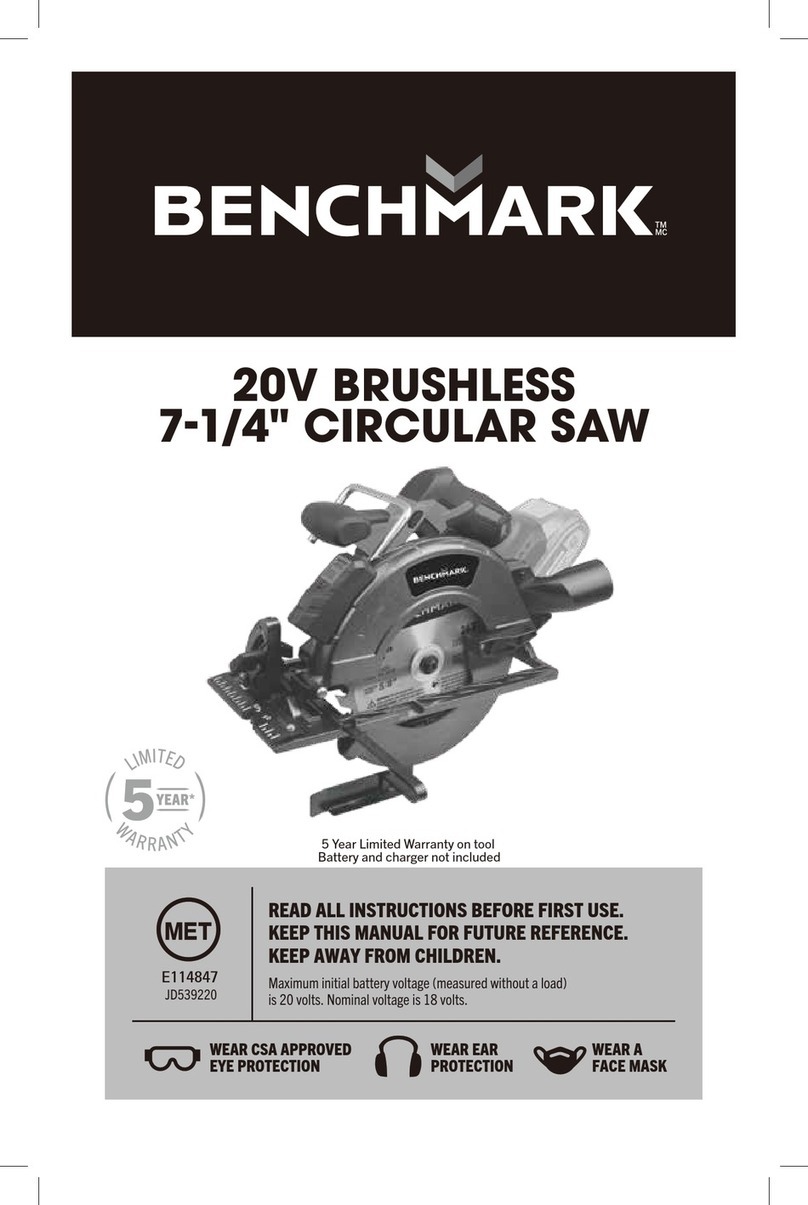
Benchmark
Benchmark 1265-002 User manual
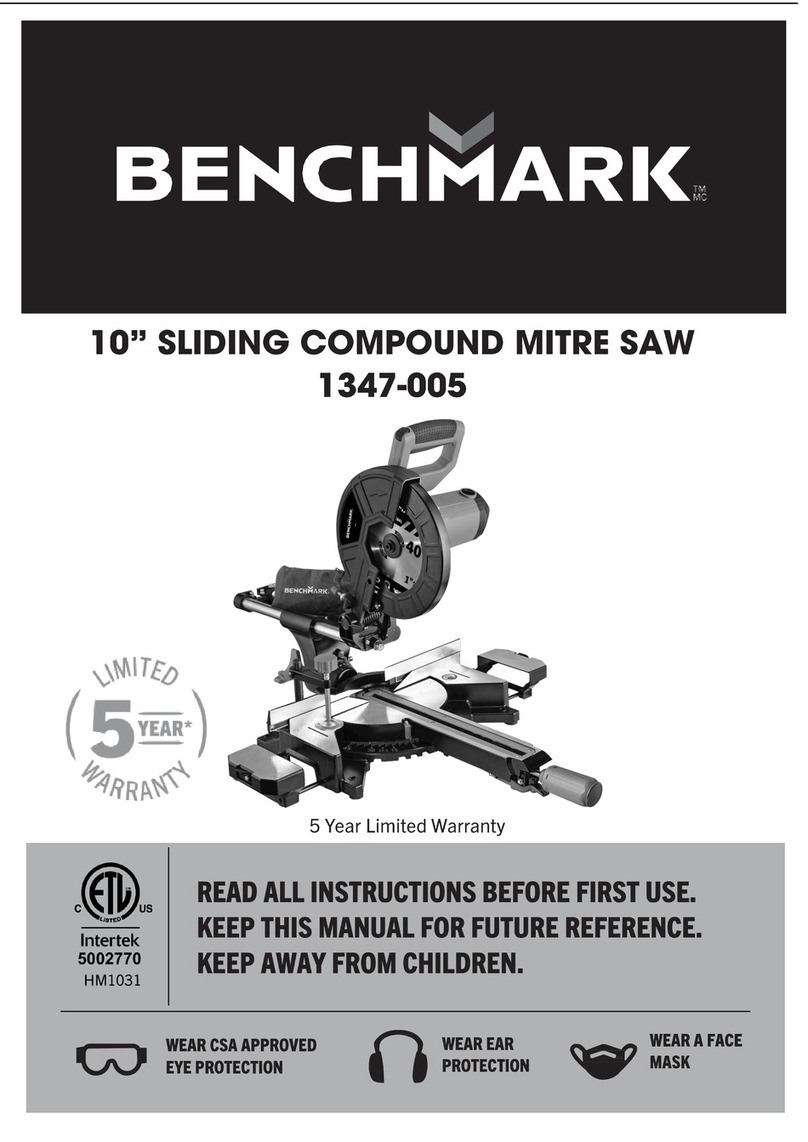
Benchmark
Benchmark 1347-005 User manual
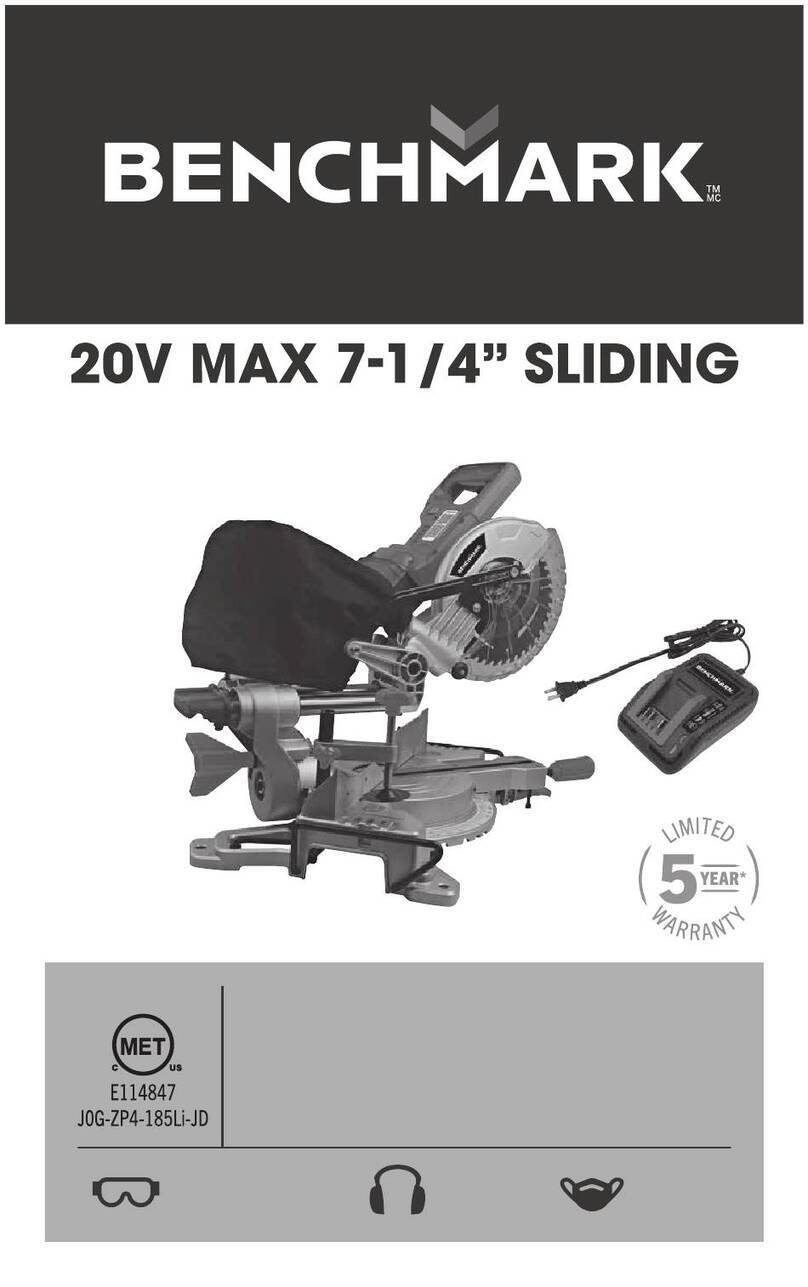
Benchmark
Benchmark 1347-001 User manual
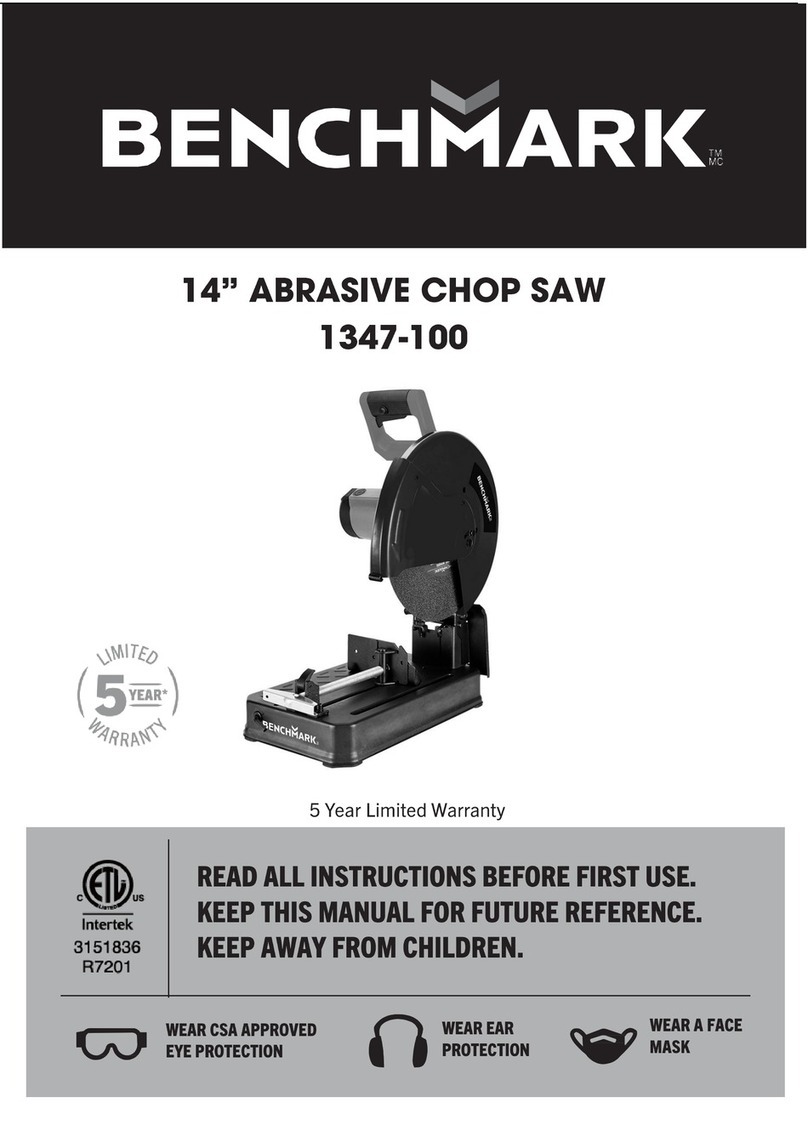
Benchmark
Benchmark 1347-100 User manual

Benchmark
Benchmark 1270-204 User manual

Benchmark
Benchmark 1265-000 User manual
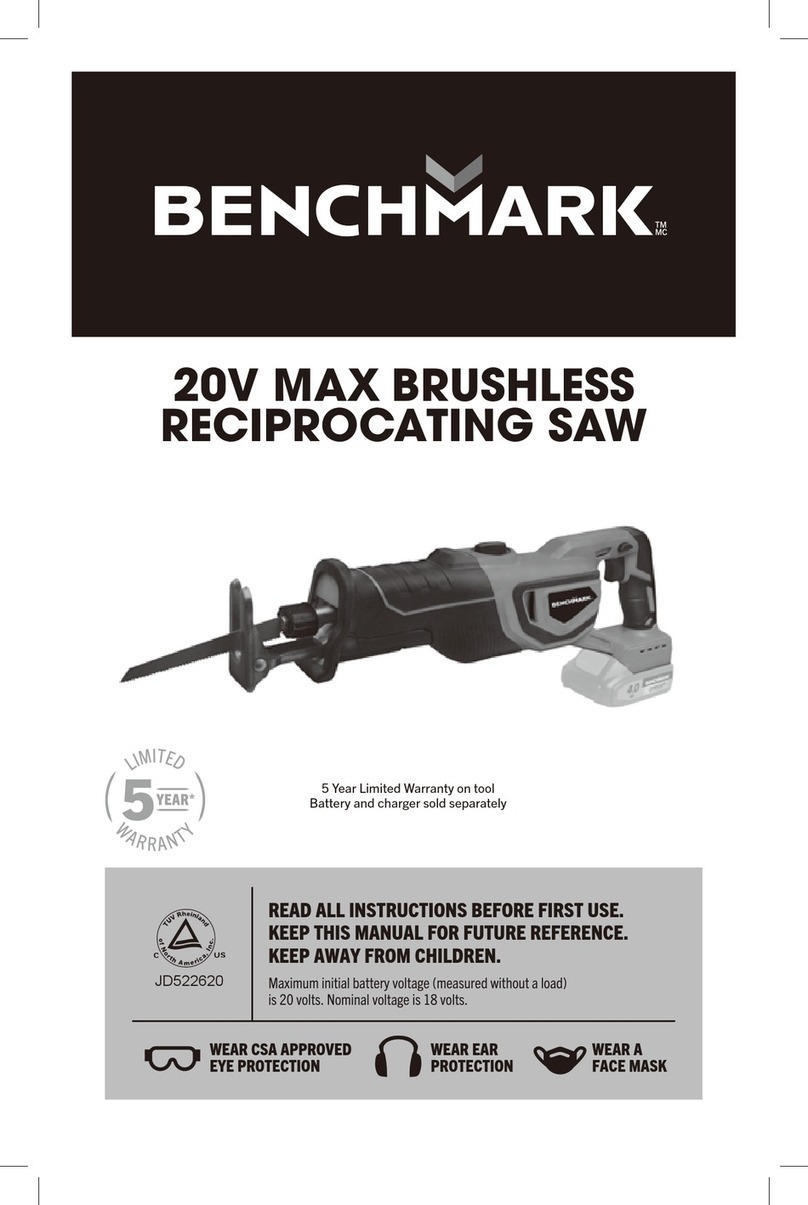
Benchmark
Benchmark 1270-205 User manual
Popular Saw manuals by other brands
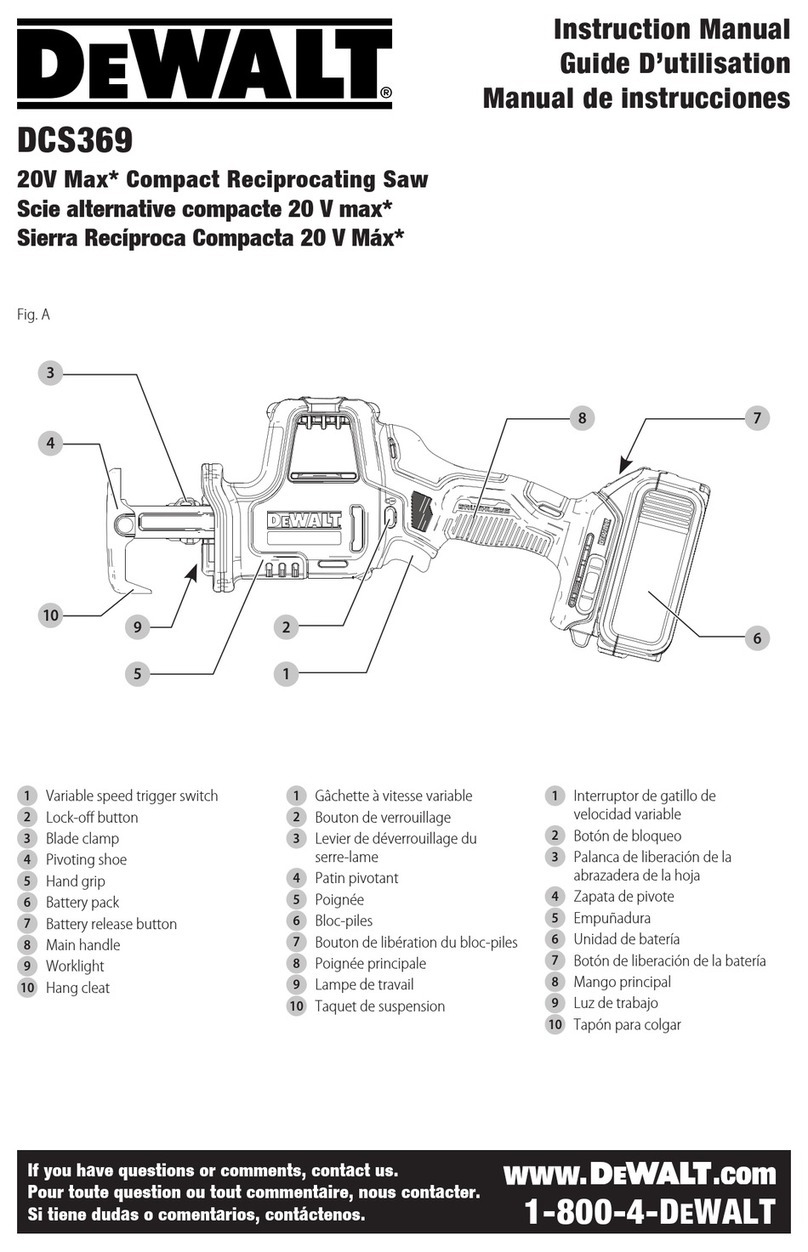
DeWalt
DeWalt DCS369 instruction manual

Chicago Electric
Chicago Electric 61971 Owner's manual & safety instructions
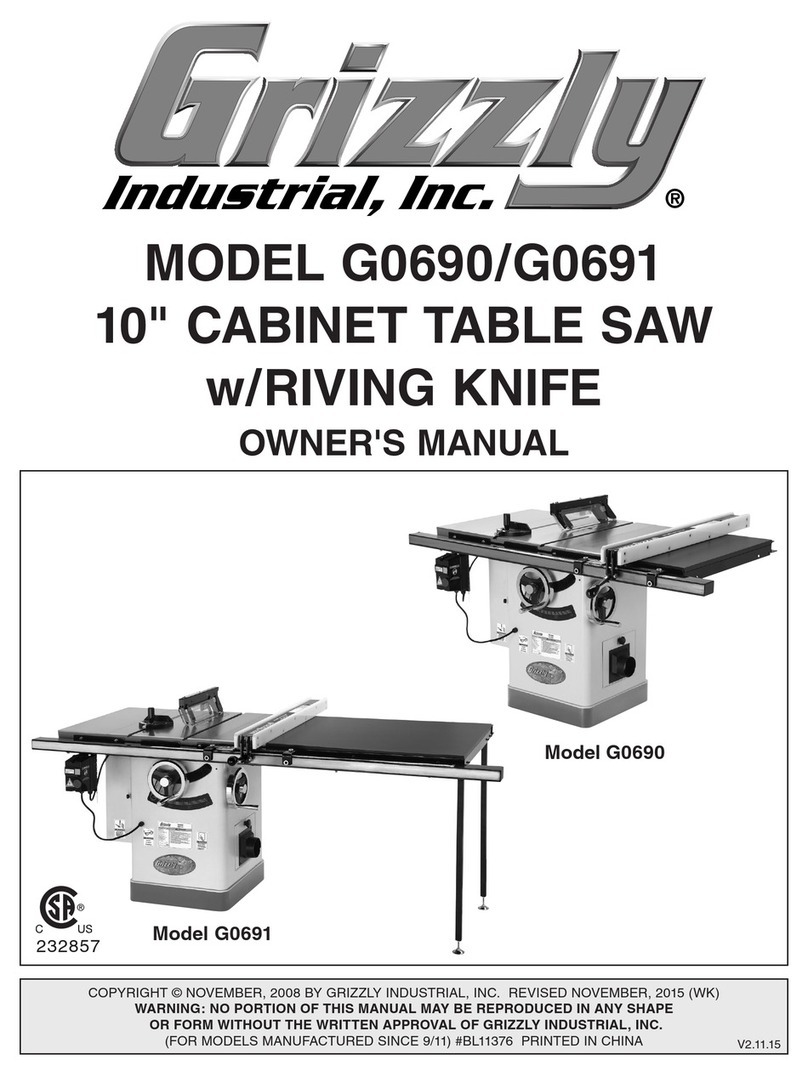
Grizzly
Grizzly G0690 owner's manual

Chicago Electric
Chicago Electric 98199 Set up and operating instructions
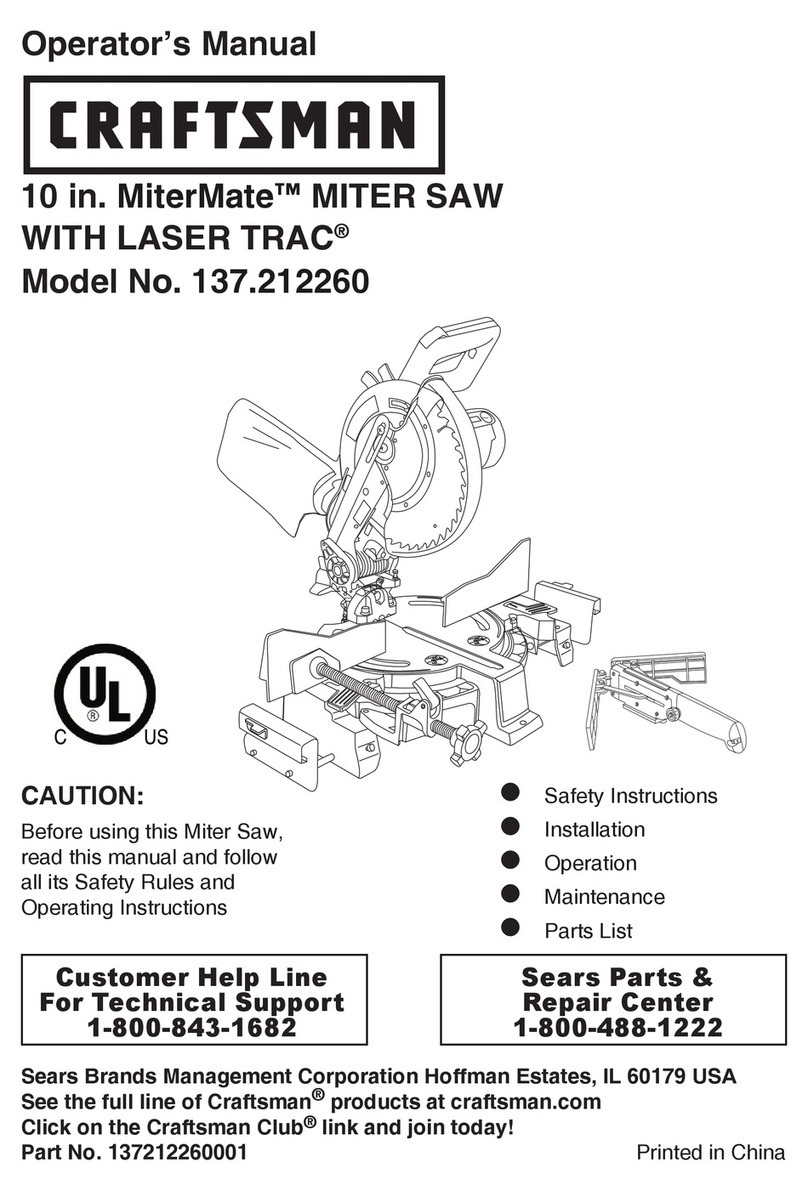
Craftsman
Craftsman MiterMate 137.212260 Operator's manual

Makita
Makita M5802 instruction manual
